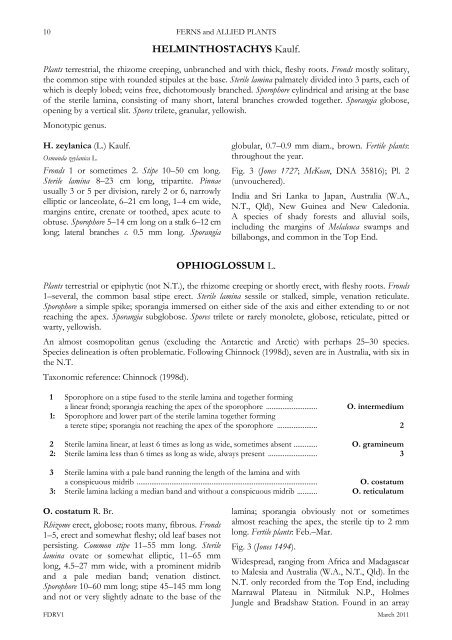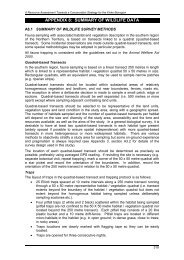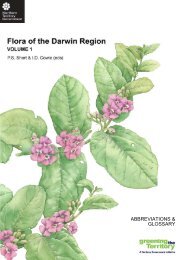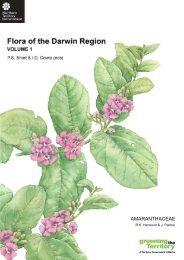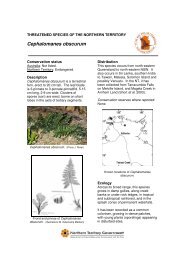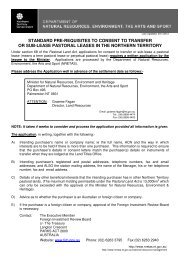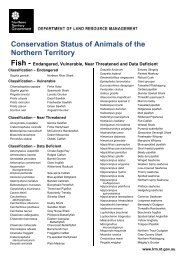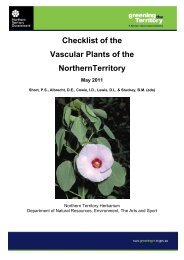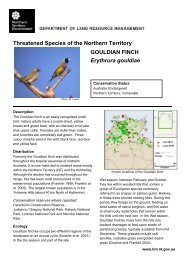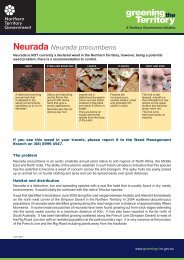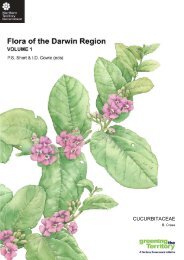ferns and allied plants - Department of Land Resource Management ...
ferns and allied plants - Department of Land Resource Management ...
ferns and allied plants - Department of Land Resource Management ...
You also want an ePaper? Increase the reach of your titles
YUMPU automatically turns print PDFs into web optimized ePapers that Google loves.
10<br />
FERNS <strong>and</strong> ALLIED PLANTS<br />
HELMINTHOSTACHYS Kaulf.<br />
Plants terrestrial, the rhizome creeping, unbranched <strong>and</strong> with thick, fleshy roots. Fronds mostly solitary,<br />
the common stipe with rounded stipules at the base. Sterile lamina palmately divided into 3 parts, each <strong>of</strong><br />
which is deeply lobed; veins free, dichotomously branched. Sporophore cylindrical <strong>and</strong> arising at the base<br />
<strong>of</strong> the sterile lamina, consisting <strong>of</strong> many short, lateral branches crowded together. Sporangia globose,<br />
opening by a vertical slit. Spores trilete, granular, yellowish.<br />
Monotypic genus.<br />
H. zeylanica (L.) Kaulf.<br />
Osmunda zeylanica L.<br />
Fronds 1 or sometimes 2. Stipe 10–50 cm long.<br />
Sterile lamina 8–23 cm long, tripartite. Pinnae<br />
usually 3 or 5 per division, rarely 2 or 6, narrowly<br />
elliptic or lanceolate, 6–21 cm long, 1–4 cm wide,<br />
margins entire, crenate or toothed, apex acute to<br />
obtuse. Sporophore 5–14 cm long on a stalk 6–12 cm<br />
long; lateral branches c. 0.5 mm long. Sporangia<br />
OPHIOGLOSSUM L.<br />
globular, 0.7–0.9 mm diam., brown. Fertile <strong>plants</strong>:<br />
throughout the year.<br />
Fig. 3 (Jones 1727; McKean, DNA 35816); Pl. 2<br />
(unvouchered).<br />
India <strong>and</strong> Sri Lanka to Japan, Australia (W.A.,<br />
N.T., Qld), New Guinea <strong>and</strong> New Caledonia.<br />
A species <strong>of</strong> shady forests <strong>and</strong> alluvial soils,<br />
including the margins <strong>of</strong> Melaleuca swamps <strong>and</strong><br />
billabongs, <strong>and</strong> common in the Top End.<br />
Plants terrestrial or epiphytic (not N.T.), the rhizome creeping or shortly erect, with fleshy roots. Fronds<br />
1–several, the common basal stipe erect. Sterile lamina sessile or stalked, simple, venation reticulate.<br />
Sporophore a simple spike; sporangia immersed on either side <strong>of</strong> the axis <strong>and</strong> either extending to or not<br />
reaching the apex. Sporangia subglobose. Spores trilete or rarely monolete, globose, reticulate, pitted or<br />
warty, yellowish.<br />
An almost cosmopolitan genus (excluding the Antarctic <strong>and</strong> Arctic) with perhaps 25–30 species.<br />
Species delineation is <strong>of</strong>ten problematic. Following Chinnock (1998d), seven are in Australia, with six in<br />
the N.T.<br />
Taxonomic reference: Chinnock (1998d).<br />
1 Sporophore on a stipe fused to the sterile lamina <strong>and</strong> together forming<br />
a linear frond; sporangia reaching the apex <strong>of</strong> the sporophore ............................ O. intermedium<br />
1: Sporophore <strong>and</strong> lower part <strong>of</strong> the sterile lamina together forming<br />
a terete stipe; sporangia not reaching the apex <strong>of</strong> the sporophore ...................... 2<br />
2 Sterile lamina linear, at least 6 times as long as wide, sometimes absent ............. O. gramineum<br />
2: Sterile lamina less than 6 times as long as wide, always present ........................... 3<br />
3 Sterile lamina with a pale b<strong>and</strong> running the length <strong>of</strong> the lamina <strong>and</strong> with<br />
a conspicuous midrib ................................................................................................... O. costatum<br />
3: Sterile lamina lacking a median b<strong>and</strong> <strong>and</strong> without a conspicuous midrib ........... O. reticulatum<br />
O. costatum R. Br.<br />
Rhizome erect, globose; roots many, fibrous. Fronds<br />
1–5, erect <strong>and</strong> somewhat fleshy; old leaf bases not<br />
persisting. Common stipe 11–55 mm long. Sterile<br />
lamina ovate or somewhat elliptic, 11–65 mm<br />
long, 4.5–27 mm wide, with a prominent midrib<br />
<strong>and</strong> a pale median b<strong>and</strong>; venation distinct.<br />
Sporophore 10–60 mm long; stipe 45–145 mm long<br />
<strong>and</strong> not or very slightly adnate to the base <strong>of</strong> the<br />
lamina; sporangia obviously not or sometimes<br />
almost reaching the apex, the sterile tip to 2 mm<br />
long. Fertile <strong>plants</strong>: Feb.–Mar.<br />
Fig. 3 (Jones 1494).<br />
Widespread, ranging from Africa <strong>and</strong> Madagascar<br />
to Malesia <strong>and</strong> Australia (W.A., N.T., Qld). In the<br />
N.T. only recorded from the Top End, including<br />
Marrawal Plateau in Nitmiluk N.P., Holmes<br />
Jungle <strong>and</strong> Bradshaw Station. Found in an array<br />
FDRV1 March 2011


